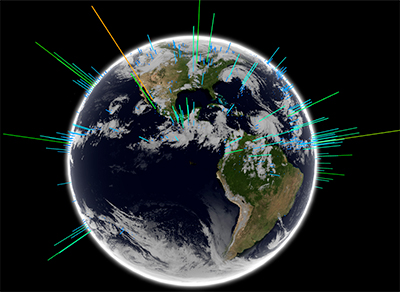Source: Journal of Geophysical Research: Atmospheres
In 1909, a wood-hulled yacht called the Carnegie sailed roughly 480,000 kilometers around the world’s oceans, gathering measurements of atmospheric electricity known collectively as the global electric current (GEC). The researchers aboard discovered a daily “pulse” in this current, known as the Carnegie curve, which is driven by electrified weather such as thunderstorms. Now, new satellite data confirm the observations made over more than a century ago and reveal for the first time how electrified clouds over land and the oceans power this circuit.
The GEC connects Earth’s upper atmosphere, where charged particles are abundant, to the planet’s surface, where the voltage drops by about 200,000 to 500,000 volts. Scientists have long struggled to study the surges of energy that link the two zones, called Wilson currents, in part because pollution and nearby pointed objects like trees and towers cause errors in the ground-based measurements. The value of the Carnegie expedition is that it was able to venture to clean ocean regions far from civilization to measure the planet’s electrical pulse.

To better understand how thunderstorms and electrified shower clouds contribute to global Wilson currents, Peterson et al. analyzed data from more than 90,000 orbits of two satellites that capture snapshots of storms across Earth. Using an algorithm that can infer the electrical field of a cloud based on the physics of its ice crystals, they found that Earth’s mean current is 1.6 kiloamperes, a number that fits well with previous measurements of the Carnegie curve. The satellite data also confirmed a long-held but untested hypothesis: that electrical storms in the ocean are a major contributor to the GEC.
The authors note that there are still types of electrified clouds whose complex dynamics distribute electrical charge in unique ways that are not fully represented in the study. How these clouds interact with Earth’s GEC is still an important question in the atmospheric electricity community. The team next plans to study the complex electrical dynamics of stratiform clouds, which can consist of as many as six alternating layers of polarity. These clouds likely complicate the generation of Wilson current. Ultimately, the research could help scientists understand how changes in global electrified weather driven by climate patterns then affect Earth’s global electric circuit and the electrodynamics of the ionosphere. (Journal of Geophysical Research: Atmospheres, https://doi.org/10.1002/2016JD026336, 2017)
—Emily Underwood, Freelance Writer
Citation:
Underwood, E. (2017), Ocean showers power the global electric circuit, Eos, 98, https://doi.org/10.1029/2017EO085441. Published on 26 October 2017.
Text © 2017. The authors. CC BY-NC-ND 3.0
Except where otherwise noted, images are subject to copyright. Any reuse without express permission from the copyright owner is prohibited.

